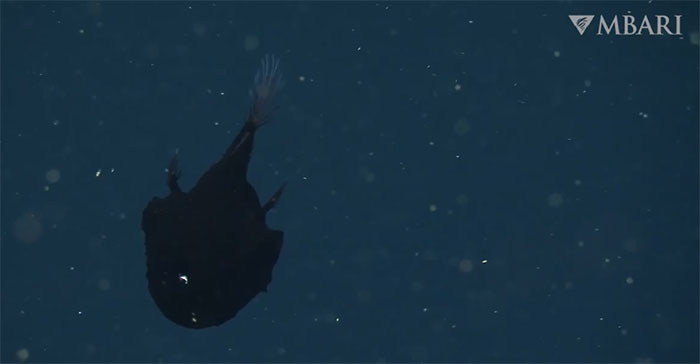Rare super black fish swim at a depth of nearly 800m
Scientists recorded an ultra-black anglerfish with the ability to absorb at least 99.5% of light in the deep sea off the coast of California.
Super black anglerfish swim in the deep sea off the coast of California, USA. (Video: MBARI)
A team of scientists from the Monterey Bay Aquarium Research Institute (MBARI) discovered an unidentified fish belonging to the genus Oneirodes , order Lophiiformes (Anglerfish or Anglerfish), Live Science reported on November 15. They recorded the animal at a depth of 781 m underwater using a remotely operated vehicle (ROV) in Monterey Canyon, a massive underground canyon stretching more than 470 km off the coast of California, USA.
The team came across this football-sized fish while collecting small, spiny creatures called phaeodarian - which float in the water column and feed on falling organic debris (marine snow). . According to a statement by MBARI, this is the first Oneirodes fish observed in Montere y Alley since 2016.
In the video, marine snow floats around the animal, but viewers can barely see its details except for the outline of its body. The reason is that the fish's skin is so dark that it absorbs a large amount of light and acts as an invisibility cloak, according to Bruce Robinson, senior scientist at MBARI.

The skin of this fish contains a lot of melanosomes - cells containing melanin pigment.
This fish belongs to the group of "super black" deep sea creatures , absorbing at least 99.5% of incoming light. According to a study in the journal Current Biology in 2020, there are 15 other marine species capable of absorbing such large amounts of light. Research has revealed that their skin contains a lot of melanosomes - cells containing the pigment melanin, which is also the pigment that gives color to human skin. The shape and structure of these cells allows them to absorb most wavelengths of light that hit the skin.
"The ultra-black skin causes all incoming light, including the bright light from the fish's streetlight-like lure, to be completely absorbed. Nothing reflects to reveal the location," co-author explains researcher Karen Osborn, a zoologist at the Smithsonian National Museum of Natural History and MBARI. This allows the Oneirodes fish to hide while lying in wait and use a fluorescent lure that resembles a fishing rod to lure prey.
Their strange camouflage ability also helps them hide from enemies. When the MBARI team discovered the Oneirodes fish , it was using bait. But the animal quickly "turned off" when it realized it was being followed. The team of scientists determined this was a female based on its size. Female Oneirodes fish can be up to 37cm long, while males are only about 1.3cm long.
- Capture the rare sight of a transparent head fish swimming at a depth of 800m
- Discovering super rare fish in the sea
- Thousands of children swim close to each other but without collisions, what is the secret of fish?
- Surprising scientists discovered a new ecosystem at the bottom of the ocean with a depth of 3,800m
- The robot fish can swim at a depth of 15m without being detected
- Extremely rare footage of fish living at a record depth of 6,100m under the sea floor
- Fish at a depth of nearly 400 meters drifted to the US coast
- Fish can live up to a depth of 8.200m
- Strange fish live at a depth of 1,500 meters washed up on the Alaska coast
- Top 10 rare and expensive fishes in Vietnam
- Fish live at a depth of 7.7 km
- Catching a super rare scene in the universe: Super giant black hole is swallowing up a star
 Surprised: Fish that live in the dark ocean still see colors
Surprised: Fish that live in the dark ocean still see colors Japan suddenly caught the creature that caused the earthquake in the legend
Japan suddenly caught the creature that caused the earthquake in the legend A series of gray whale carcasses washed ashore on California's coast
A series of gray whale carcasses washed ashore on California's coast Compare the size of shark species in the world
Compare the size of shark species in the world